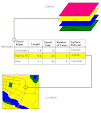I received the 2009 imagery from the Alexandria, LA NRCS office on Monday, October 26 and have been working with it ever since. The imagery includes all of Vermilion Parish, so I've trimmed it down to the Coulee Baton watershed, including the downstream part of Coulee Baton that is not part of the microwatershed project.
The land use polygons have to be created manually by hand, and I've started on the human habitation polygons. I still need to touch base with the Abbeville Farm Service office for current crop data.
I have the 2006 maps on one screen, and the 2009 imagery on the other - the apparent human habitation is much more dense on the 2009 than on the 2006.
Saturday, October 31, 2009
Friday, October 23, 2009
Beautiful Images
More Watershed Analysis
I have downloaded 3-meter resolution NED files from the USDA Geospatial Data Gateway. I have mosaicked the ones from my study area, and extracted a smaller area of the mosaic using a mask.
I have run the hydrology tools on this NED, and have had much better results than with the first DEMs (10 meter resolution). I want to run them using pour points instead of the area-wide tools I've been using, see how those results compare with my current results.
My main problem is, the textbook I'm using doesn't go into as much depth as I'd like on this subject. It references other works, but so far I haven't gotten my hands on them. I have questions regarding the accuracy of the watershed analysis tools. My watersheds almost, but not quite, agree with the hydrology unit layer I've downloaded from the USDA website. I've downloaded both the 8- and 12- digit layers. What do GIS analysts do when confronted with this kind of conflict?
I've been spending all my time on the watershed analysis tools, and I need to get busy with the basics - land use, etc.
Bob Capezza is supposed to send me the 2009 NAIP files for Vermilion Parish via DVD. I've downloaded the 2007 layer, which is the latest available on the USDA web site.
I need to contact the Abbeville NRCS and Farm Service people on the land use data because previous GIS information on Coulee Baton was lost in a computer crash.
I have run the hydrology tools on this NED, and have had much better results than with the first DEMs (10 meter resolution). I want to run them using pour points instead of the area-wide tools I've been using, see how those results compare with my current results.
My main problem is, the textbook I'm using doesn't go into as much depth as I'd like on this subject. It references other works, but so far I haven't gotten my hands on them. I have questions regarding the accuracy of the watershed analysis tools. My watersheds almost, but not quite, agree with the hydrology unit layer I've downloaded from the USDA website. I've downloaded both the 8- and 12- digit layers. What do GIS analysts do when confronted with this kind of conflict?
I've been spending all my time on the watershed analysis tools, and I need to get busy with the basics - land use, etc.
Bob Capezza is supposed to send me the 2009 NAIP files for Vermilion Parish via DVD. I've downloaded the 2007 layer, which is the latest available on the USDA web site.
I need to contact the Abbeville NRCS and Farm Service people on the land use data because previous GIS information on Coulee Baton was lost in a computer crash.
Tuesday, October 6, 2009
Not Thrilled with Results of Watershed Tool
I ran some tools on my mosaicked DEM, got some good preliminary results, but the result of the watershed tool was a value of 1, which gives a map that is one solid color. That's not what you want.
I need to re-run some of the preparatory tools again with different values, see if I come up with any new results. I might not, because the D8 algorithm in ArcMap is fast and efficient of computer resources, but is known to work much better on areas with more relief than I have in my very flat watershed.
I need to re-run some of the preparatory tools again with different values, see if I come up with any new results. I might not, because the D8 algorithm in ArcMap is fast and efficient of computer resources, but is known to work much better on areas with more relief than I have in my very flat watershed.
Friday, October 2, 2009
Coulee Baton DEMs
I've downloaded the LiDAR DEMs and contours for the study area. I have mosaicked the DEMs into one raster preparatory to running the ArcTools watershed analysis tools.
Next step - contact the NRCS people involved in the project planning and see what kind of land use or other data layers they might have that will be pertinent to the project.
Next step - contact the NRCS people involved in the project planning and see what kind of land use or other data layers they might have that will be pertinent to the project.
Subscribe to:
Posts (Atom)


